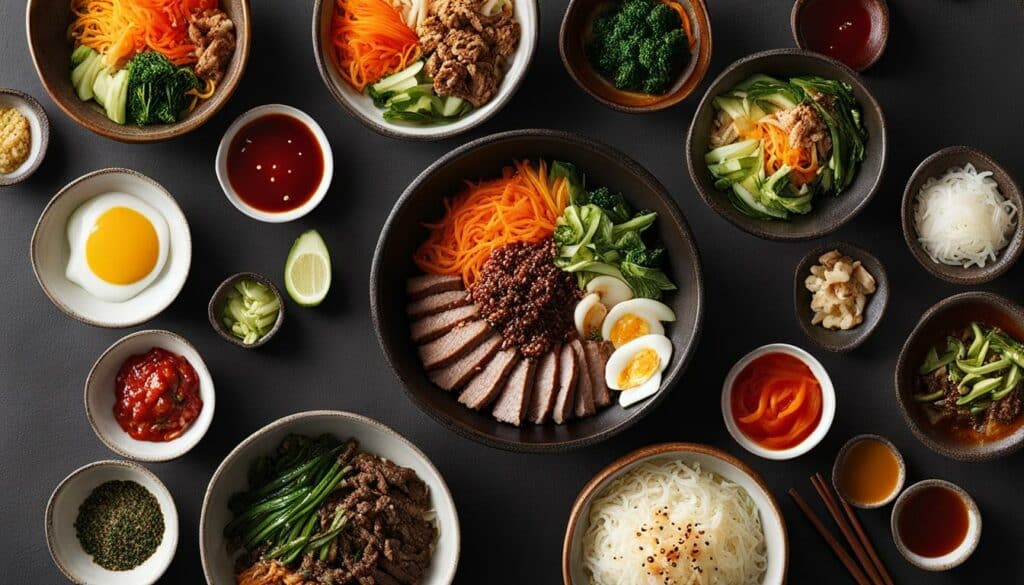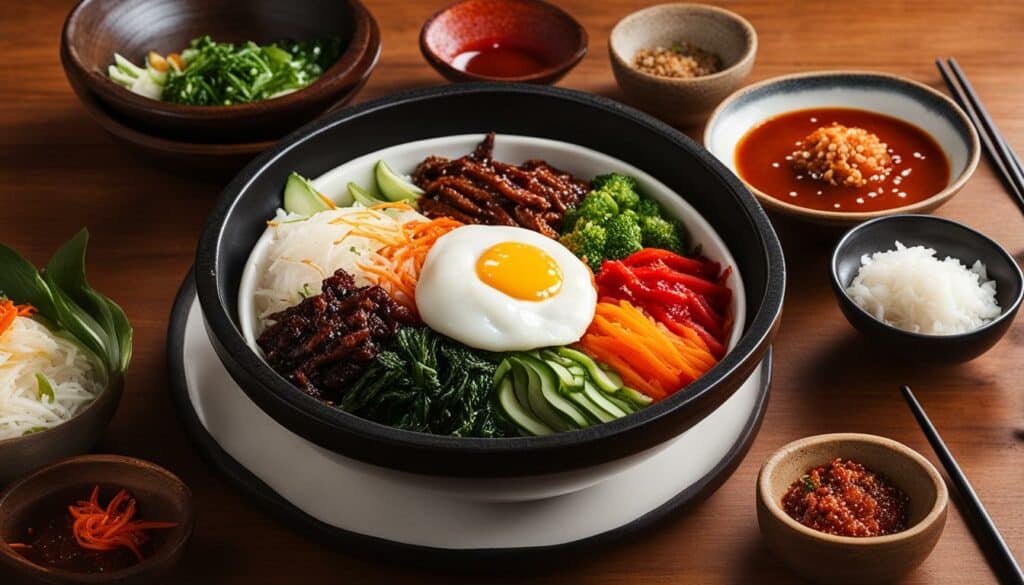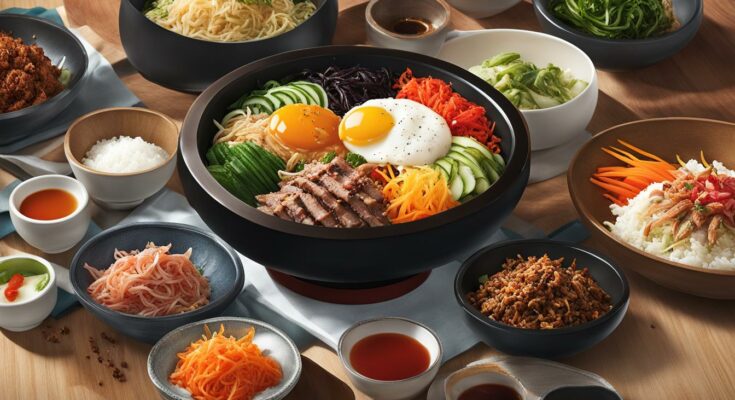Welcome to our exploration of bibimbap, a delicious Korean rice bowl dish that has captivated food lovers worldwide. In this article, we will delve into the flavors and taste profile of bibimbap, uncovering the secrets behind its unique and mouthwatering taste.
Bibimbap is renowned for its diverse flavors that come together in perfect harmony. Imagine a medley of savory, sweet, and spicy tastes dancing on your palate, creating a truly tantalizing experience. The combination of ingredients such as ground beef, crunchy vegetables, and the signature gochujang sauce contributes to the rich and satisfying flavor of bibimbap.
The fresh and crunchy vegetables add a refreshing element, while the meat provides depth and richness. The gochujang sauce, made with fermented Korean chili paste, introduces a tangy and spicy kick that elevates the dish to new levels of deliciousness.
Bibimbap’s taste profile is a testament to the creativity and culinary traditions of Korea, with each region showcasing its unique variations and flavors. From the traditional taste rooted in fresh seasonal ingredients to the modern twists that incorporate different sauces, bibimbap offers a world of flavors to be explored and savored.
Key Takeaways:
- Bibimbap is a Korean rice bowl dish known for its diverse flavors.
- The taste profile of bibimbap includes savory, sweet, and spicy elements.
- Vegetables provide freshness and crunch, while meat adds richness.
- Gochujang sauce, made with fermented Korean chili paste, adds tanginess and spice.
- Bibimbap showcases the creativity and culinary traditions of Korea.
The Origins of Bibimbap
Bibimbap, a beloved Korean dish, has a rich history that dates back to the 19th century. It is believed to have originated as a meal for farmers during the harvest season. With its convenient and filling nature, bibimbap quickly became a popular choice for those working in the fields. The traditional taste of bibimbap is deeply rooted in its use of fresh and seasonal ingredients, which vary depending on the region and the time of year.
The authentic flavors of bibimbap come from the combination of different vegetables, meat, and the bold flavors of the gochujang sauce. Each region in Korea has its own variations and unique flavors, making bibimbap a diverse and exciting dish to try. This cultural diversity further adds to the authenticity and richness of bibimbap’s flavors.
| Region | Ingredients | Flavors |
|---|---|---|
| Jeonju | Soybean sprouts, cucumbers, mushrooms, beef, and raw egg yolk | Mild, balanced, and harmonious |
| Bibimbap Alley in Jeonju | Assorted vegetables, beef, and gochujang sauce | Spicy and flavorful |
| Tongyeong | Seafood, vegetables, and gochujang sauce | Fresh, briny, and spicy |
These regional variations highlight the diversity of flavors found within bibimbap and showcase the importance of preserving authentic tastes and culinary traditions.
The Evolution of Bibimbap
Over the years, bibimbap has evolved and adapted to different tastes and preferences. While the traditional bibimbap typically consisted of a combination of rice, vegetables, meat, and gochujang sauce, modern variations have expanded to include creative twists and innovative ingredients.
- Bibim-noodles: A variation that replaces rice with noodles, providing a different texture and flavor profile.
- Dolsot-bibimbap: Served in a hot stone bowl, this version creates a crispy rice crust at the bottom, adding a unique and delicious element to the dish.
- Vegan bibimbap: With a growing interest in plant-based diets, vegan bibimbap offers a meat-free alternative while still maintaining the vibrant flavors of the dish.
These modern adaptations reflect the evolving nature of bibimbap and its ability to cater to different tastes and dietary preferences.
The Components of Bibimbap
Bibimbap is a delightful dish that tantalizes the taste buds with its unique combination of flavors. To truly appreciate the deliciousness of bibimbap, it is essential to understand its various components. Each ingredient contributes to the overall taste profile of this savory Korean rice bowl.
Rice
The foundation of bibimbap is a bed of perfectly cooked short-grain rice. The rice acts as a neutral base, allowing the other ingredients to shine and meld together harmoniously.
Vegetables
A colorful assortment of sautéed vegetables adorn the rice, providing a delightful crunch and burst of freshness. Common vegetable toppings for bibimbap include spinach, soybean sprouts, and carrots. These veggies not only add texture but also contribute their own unique flavors to the dish.
Protein
For a savory twist, bibimbap often includes ground beef as the protein component. The meat is seasoned and cooked to perfection, adding richness and depth to the overall taste. The combination of the beef with the rice and vegetables creates a satisfying and well-rounded flavor profile.
Toppings
No bibimbap is complete without a variety of toppings that add extra layers of flavor. Julienned jicama, shredded carrots, and kimchi are some popular choices. These toppings provide additional texture and a touch of tanginess that elevates the taste of the dish.
When all these components come together, the result is a delicious and harmonious medley of flavors that make bibimbap a truly extraordinary culinary experience. Whether you enjoy it at a Korean restaurant or try your hand at making it at home, be prepared to be delighted by the unique and savory taste of bibimbap.

The Role of Gochujang Sauce

Bibimbap is undoubtedly a delightful culinary experience, and one of the key contributors to its flavorful profile is the famous gochujang sauce. This spicy condiment plays a crucial role in enhancing the taste of this traditional Korean dish. Made from fermented Korean chili paste, gochujang sauce adds a unique and complex flavor that elevates the overall dining experience.
The flavor profile of gochujang sauce is a perfect balance of pungency, spiciness, sweetness, and saltiness. Its slightly pungent notes, combined with a tangy and spicy kick, create a mouthwatering taste that tantalizes the taste buds. When mixed with other ingredients in bibimbap, the gochujang sauce harmonizes the flavors and brings them together, resulting in a savory and delightful blend.
Whether you prefer a milder or spicier version, gochujang sauce allows you to customize the level of heat to your liking, adding a personalized touch to your bibimbap experience. Its versatility makes it a must-have element for an authentic and flavorsome bibimbap dish.
The Variety of Bibimbap Sauces
One of the reasons why bibimbap is such a versatile and delicious dish is the variety of sauces that can be used to enhance its flavor. While the traditional gochujang sauce is the most common and widely used, there are other options that offer different taste profiles and experiences.
One of these variations is a garlic gochujang sauce. By incorporating garlic, honey, sesame oil, and rice vinegar into the gochujang base, a new dimension of flavor is added to the dish. The garlic provides a savory and aromatic element, while the honey adds a touch of sweetness. The sesame oil brings a nutty flavor, and the rice vinegar provides a subtle tanginess.
For those who enjoy a smoky and meaty taste, a ground meat-based sauce is a great option. By combining cooked ground beef or pork with gochujang sauce, the sauce takes on a rich and savory flavor profile that complements the other ingredients in bibimbap perfectly.
Another alternative is a funky doenjang bibimbap sauce. Doenjang is a fermented Korean miso paste, which adds a unique umami taste to the dish. By mixing doenjang with other ingredients like gochujang and sesame oil, a whole new flavor experience is created, with a depth and complexity that is hard to resist.
Lastly, for those who prefer a non-spicy option, a kid-friendly soy bibimbap sauce is a great choice. This sauce incorporates soy sauce, sesame oil, and other seasonings to create a mild and flavorful alternative to the traditional gochujang sauce. It still captures the essence of bibimbap with its delicious taste, making it a suitable option for those with a milder palate or young children.
With these variations in bibimbap sauces, you can customize your dish to suit your taste preferences and explore different flavor combinations. Whether you prefer a traditional gochujang sauce or want to experiment with different flavors, the variety of bibimbap sauces allows for a truly personalized and exciting culinary experience.
Table: Comparison of Bibimbap Sauces
| Sauce Type | Flavor Profile | Main Ingredients |
|---|---|---|
| Traditional Gochujang Sauce | Spicy, tangy, sweet, savory | Gochujang, Korean chili paste |
| Garlic Gochujang Sauce | Savory, sweet, aromatic | Gochujang, garlic, honey, sesame oil, rice vinegar |
| Ground Meat Sauce | Smoky, savory | Gochujang, cooked ground beef or pork |
| Doenjang Bibimbap Sauce | Umami, rich, complex | Doenjang (Korean miso paste), gochujang, sesame oil |
| Kid-Friendly Soy Bibimbap Sauce | Mild, flavorful | Soy sauce, sesame oil, other seasonings |
The Importance of Family and Tradition in Bibimbap
Bibimbap is more than just a delicious dish; it holds significant cultural and familial importance in Korean cuisine. This traditional rice bowl meal is often prepared and enjoyed together as a family, bringing loved ones closer and preserving culinary traditions that have been passed down from generation to generation. The authentic flavors of bibimbap are deeply rooted in this rich familial and cultural heritage.
The preparation and sharing of bibimbap create a sense of togetherness and unity, as family members gather around the table to participate in the making of the dish. From cooking the rice to arranging the colorful array of toppings, each step is a collaborative effort that strengthens family bonds. The act of sharing the meal further reinforces the importance of family and tradition in Korean culture.
“Bibimbap is a dish that brings families together and carries on our culinary heritage. It is a way of showing love and care for our loved ones.”
Preserving Tradition Through Taste
The traditional taste of bibimbap is a reflection of the local flavors and seasonal ingredients found in different regions of Korea. From the fresh and vibrant vegetables to the savory and bold gochujang sauce, each component represents the distinct gastronomic traditions of the area. These authentic flavors have been cherished for centuries and continue to be celebrated today.
Bibimbap not only satisfies the taste buds but also nourishes the soul. It is a reminder of the importance of family, tradition, and the cultural heritage that connects us to our roots. Whether enjoyed in a humble home or a bustling restaurant, bibimbap brings people together, celebrating the flavors and memories that have been shared for generations.
The Beauty of Tradition
The beauty of bibimbap lies not only in its exquisite flavors but also in the stories and traditions that accompany each bite. As one savors the harmonious combination of ingredients, they are transported to a time when this dish was prepared with love and care by generations before them. Each spoonful tells a tale of heritage and the strength of family ties.
Whether it’s the first taste of bibimbap or a cherished family recipe passed down through the years, the authentic flavors of this traditional dish are a testament to the enduring power of family and tradition. It is a reminder that food has the ability to bring people together, transcending time and creating lasting memories.
Exploring the Origins and Taste of Bibimbap
Delving into the origins and taste of bibimbap allows us to uncover the rich history and unique flavors of this beloved Korean dish. With its roots as a traditional farmer’s meal during the harvest season, bibimbap showcases its practicality and ability to nourish large groups of people. But it’s not just about sustenance; bibimbap offers a diverse and exciting taste experience that captivates the palate.
The combination of various components in bibimbap results in a harmonious blend of flavors. The sautéed vegetables, such as spinach and soybean sprouts, provide freshness and a delightful crunch. The savory ground beef adds richness and depth, while the fried egg contributes creaminess. And let’s not forget the star of the show—the gochujang sauce. Made from fermented Korean chili paste, it brings a tangy, spicy kick that ties everything together.
“Bibimbap is a dish that embodies the diverse and delicious flavors of Korean cuisine.”
Customizing the Bibimbap Experience
One of the joys of exploring bibimbap is the opportunity to customize it according to your taste preferences. Whether you prefer a milder version or like to turn up the heat, there are various sauces and toppings to enhance the flavor profile. From garlic gochujang sauce to smoky meat-infused variations, there’s a range of options to suit every palate.
For those who want to experience the authentic taste of bibimbap, sticking to the traditional gochujang sauce is the way to go. Its unique blend of pungent, spicy, sweet, and salty flavors perfectly complements the other ingredients. However, for those who prefer a milder option, a non-spicy soy bibimbap sauce is a great choice. This sauce allows you to enjoy the essence of bibimbap without the fiery kick.
Conclusion
Bibimbap is a culinary masterpiece that showcases the incredible flavors of Korean cuisine. From its savory, sweet, and spicy taste profile to its diverse range of ingredients, this dish is a true delight for food enthusiasts. Whether enjoying a traditional bibimbap or exploring customized variations, the flavors of bibimbap are guaranteed to satisfy your taste buds.
The combination of fresh and seasonal ingredients, along with the bold flavors of the gochujang sauce, create a harmonious and delicious taste experience. Each spoonful of bibimbap offers a burst of flavor, with ingredients like crunchy vegetables, succulent meat, and the tangy kick of the gochujang sauce. The variety of bibimbap sauces adds even more depth and customization to this already exciting dish.
Embark on a culinary adventure and experience the mouthwatering flavors of bibimbap for yourself. Whether you’re a fan of savory, sweet, or spicy flavors, bibimbap has something to satisfy every palate. So why wait? Indulge in the vibrant and tantalizing taste profile of bibimbap and discover the wonders of Korean cuisine.
Easy & Delicious Homemade Bibimbap Recipe – Savor Korean Flavors!
FAQ
What does bibimbap taste like?
Bibimbap has a combination of savory, sweet, and spicy flavors. The vegetables provide a fresh and crunchy texture, while the meat adds richness and depth. The gochujang sauce, made with fermented Korean chili paste, adds a tangy and spicy kick to the dish.
What are the unique flavors of bibimbap?
Bibimbap has a delicious and satisfying flavor that is loved by foodies all over the world. Its taste can be described as a harmonious combination of savory, sweet, and spicy flavors.
What are the components of bibimbap?
The main ingredients of bibimbap include cooked short-grain rice as the base, topped with sautéed vegetables such as spinach, soybean sprouts, and carrots. Ground beef is often added for a savory element, and a fried egg is placed on top for added richness. The dish is then garnished with various toppings, including julienned jicama, shredded carrots, and kimchi.
What is the role of gochujang sauce in bibimbap?
Gochujang sauce plays a crucial role in the flavor of bibimbap. It is made from fermented Korean chili paste, which gives it a unique and complex flavor. The sauce has a slightly pungent, spicy, sweet, and salty taste. When mixed with other ingredients, it enhances the overall flavor of the dish and adds a necessary kick of heat.
Are there different variations of bibimbap sauces?
Yes, there are different variations of bibimbap sauces. Some recipes incorporate garlic, honey, sesame oil, and rice vinegar to create a garlic gochujang sauce. Others use ground meat, such as beef or pork, to add a smoky and meaty flavor to the sauce. There is also a funky doenjang bibimbap sauce, which uses Korean miso paste for a different twist on the traditional flavors. A kid-friendly soy bibimbap sauce is also available for those who prefer a non-spicy option.
What is the significance of family and tradition in bibimbap?
Bibimbap holds significant cultural and familial importance in Korean cuisine. It is a dish that is often prepared and enjoyed together as a family, fostering a sense of togetherness and tradition. The preparation and sharing of bibimbap help to strengthen family ties and pass down culinary traditions from generation to generation.
How can I explore the origins and taste of bibimbap?
Exploring the origins and taste of bibimbap offers a deeper understanding and appreciation for this beloved Korean dish. Trying different variations and sauces allows for a personalized experience and the opportunity to discover new and exciting flavors within the dish. It is a culinary adventure that can introduce you to the diverse and mouthwatering flavors of bibimbap.




